|
|
By Jo Nova
Good news: despite 2023 being the hottest year since Homo Erectus, there was a 17% fall in the number of 18 to 34 year olds who call “Climate change” a very serious problem. Even though there were hottest ever headlines month after month, the punters lost the faith.
No one is cracking champagne, because 50% of young adults still tell pollsters they think it is a “very serious problem”. But when all is said and done, at least half the generation that was drip-fed the dogma since kindergarten can not only see through the catastrophism but they are brave enough to tell a pollster that too.
For the most part, after a few hot El Nino years, “climate fear” is back where it was in 2016 or so. Most people still want the government to solve the weather with someone else’s money. But where younger people were once much more enthusiastic about a Big Government fix than older people were, now the gap is almost closed.What was a 21% difference between those age groups is now only 2%. That’s a whopping fall in faith in the government to change the weather.
Looks like young adults are learning to be cynical adults faster?
The Monmouth university group polled 804 people in late April:
The percentage of Americans between the ages of 18 and 34 who see climate change as a very serious problem has fallen by 17 points in the past three years (50%, down from 67% in 2021), compared with smaller declines among those who are 35 to 54 years old (44%, down from 48%) and those age 55 and older (44%, down from 54%).
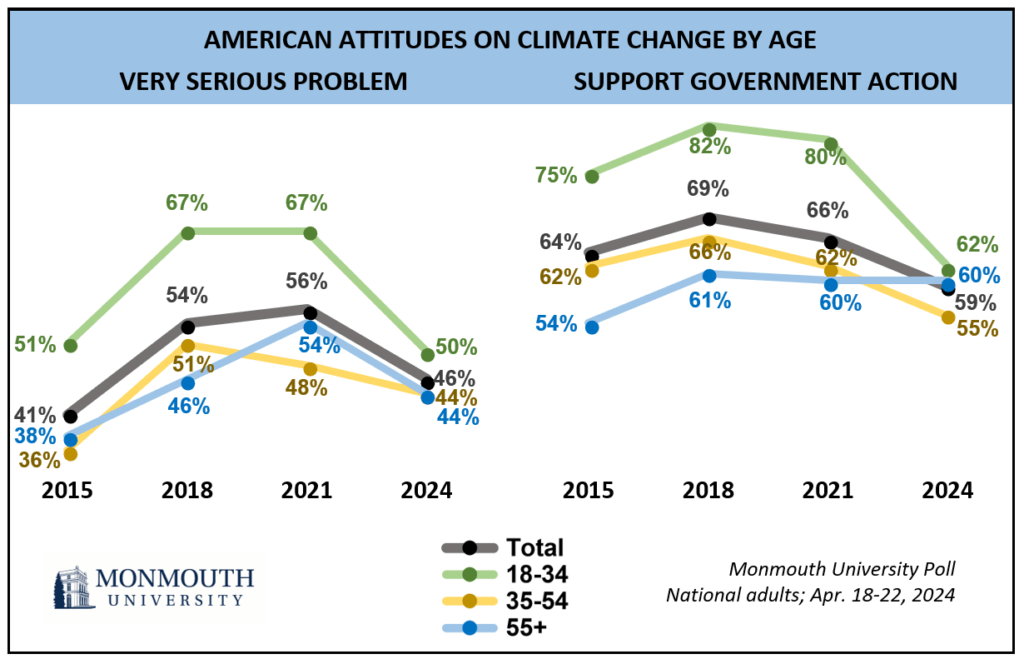 … https://www.monmouth.edu/polling-institute/reports/monmouthpoll_us_050624/ But what does “a very serious problem” even mean?
Anyone can say “it’s serious” but only 1 in 6 people can even be bothered pretending to a pollster that climate change influences their vote:
A Monmouth poll released last month found only 15% of voters view climate change as a determinative issue in how they will vote in the 2024 presidential election, ranking far lower than inflation, immigration, and abortion.
People used to lie to pollsters and say they cared, but now most don’t even pretend. In 2019 in the UK two-thirds of people agreed climate was the biggest issue facing humankind. The Guardian writers were sure that climate change would determine how most of the voters would vote, but the party promising to give them better weather lost in a landslide.
In 2015, when nearly half of US voters said climate was a “very serious problem”, other surveys showed only 3% ranked climate change as the most important issue.
If a twenty-something really believed the Antarctic ice cap was about to melt, wouldn’t it rate as a voting issue?
So let’s be clear, year after year, we see the same results. The voters don’t want to spend money on climate change and won’t change their vote, but the politicians act as though their career depends upon it.
After years of surveys like this, we know the politicians know the voters don’t care, but they go and force climate action on the voters anyway. Who are they really working for? Last year a survey showed more then half of the US thinks the people who really “run” the country are not known to voters.
Fully 92% of Democrat voters says they think climate change is real. (What else could they say, they’ve be excommunicated from friends and family if they said anything else.) Only 51% of Republicans tell pollsters they think climate change is real. But imagine how fast that would plummet if skeptical professors were interviewed on TV, and half of Republican politicians spoke for half the Republican voters?
Only a third of voters agree with the UN Experts that climate change is mainly a human driven thing
Despite the UN experts being 97% certain, only one third of voters completely agree with them. That’s really quite astounding.
Public opinion remains mixed on the degree to which human behavior contributes to change in the climate. Just over one-third (34%) say climate change is caused mainly by human activity while 31% say human activity and natural changes in the environment play equal roles. Another 7% put climate change down mainly to natural causes, with the remainder saying climate change is not happening (23%) or are not sure if it is happening (4%). Just over half of Americans (51%) say there is still time to prevent the worst effects of climate change while just 17% say it is too late.
After thirty years of scientific and media purity, only one third think climate change is “mostly human”. Another third think the UN must be exaggerating, and the last third know the UN is wrong.
REFERENCE
The Monmouth University poll, Climate Change Concerns Dip, May 6th, 2024
10 out of 10 based on 33 ratings
8.8 out of 10 based on 10 ratings
By Jo Nova
They’re not even pretending anymore
Hands up who thinks Mark Zuckerberg lies awake at night worrying that climate change will destroy Pacific islands? This is a man who fights “climate misinformation online” but destroys ecosystems on weekends…
Hypocrisy is thy name: He hopes you will use his virtual reality glasses so you can visit friends online without using a car, a boat or a plane, but he’ll visit his own friends in his $300 million mega-yacht.
In the world we thought we lived in, this would have made him a laughing stock on MSN et al, and pretty much rule him out from grandstanding on climate change, or ever being invited to the UN struggle sessions again, but we know the prostitutes for climate grants will smile and fawn, and so will the politicians, and so will the media.
But all over the internet, people are mocking him: “Don’t you love it when they lecture us about our CO2 emissions from the private jet or their super yacht?”
Hindustan Times
Mark Zuckerberg’s latest status update screams real-world billionaire choice: a $300 million superyacht. With an estimated net worth of US$180 billion per Forbes, one of the world’s richest men and founder of Meta dropped a whopping sum on a superyacht he calls Launchpad.
With a gross tonnage of 5,000 gross tons, the yacht can cruise at speeds of up to 24 knots, providing an epic cruising experience for the billionaire owner. It currently holds the 45th position as being one of the world’s largest yachts. The beast also has a helipad designed in case the Meta owner changes his mind and wants to catch a sudden flight.
Still, this is hardly out of character. Zuckerberg was caught burning $158,000 in fuel in his private jet in just two months in 2021. But the usual suspects (who say they care about CO2 emissions) seem more concerned with silencing people than with his emissions:
In March 2021, 13 environmental groups, including the Union of Concerned Scientists and Greenpeace, sent Zuckerberg a letter calling on him to commit to monitoring climate disinformation and provide more transparency about the scale of the problem.
Will Greenpeace protest the yacht? The words of an old geologist on twitter surely can’t misinform more people than a billionaire who buys a maxi-yacht. And if Zuckerberg doesn’t give a damn about climate change, why was he so happy to silence people?
Don’t just use this to squeeze Zuckerberg, any serious greenie journalist or climate charity group needs to explain why they haven’t protested, written him a letter, and turned down his party invitations. Make them pay…
10 out of 10 based on 96 ratings
8.8 out of 10 based on 10 ratings
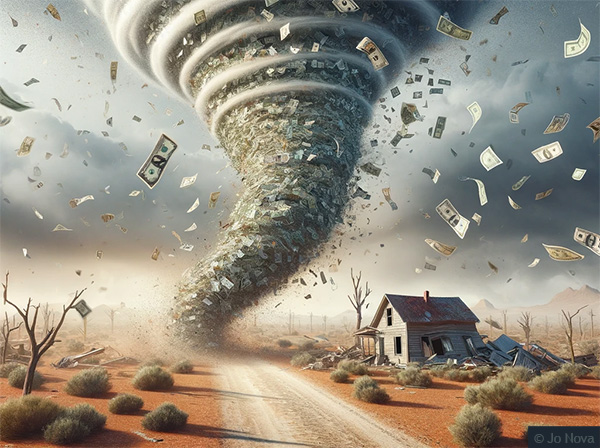
By Jo Nova
JP Morgan, BlackRock drop out of climate banker cabal, and admit the Net Zero transition is “delayed”
In February three of the four largest financial houses in the world, left the giant financial cabal called“Climate 100+” (the fourth one left a year ago). BlackRock, JP Morgan and State Street all parted ways with the billionaire-club of philanthropists trying to bully the world into buying their own renewables. In the two months since then, two of their CEO’s have put out “letters to shareholders” predicting how the transition is going to be slower and harder and how we still need fossil fuels.
Suddenly everyone sounds like an energy skeptic.
There are lots of reasons for this shift:
1: US Republican States are pointing the “AntiTrust” gun at the billionaire banker club because it looks exactly like a monopolistic cabal doing its best to collude to reduce competition. The States are also firing up the fiduciary duty canon. Hence the bankers not only want to back away from the cabal, they want to sound like bankers that care about investing their clients funds.
2. The renewables bubble is deflating fast, and the CEO’s can see what’s coming. Think of their renewable energy passion a few years ago as a pump-n-dump scheme and it all makes more sense. Right now smart bankers are smoothing the exit ramp out of the bubble they created and hoping no one notices how wrong all their previous statements were.
3. Maybe there’s a point where smart banker billionaires realize they don’t want their own homeland to hit the skids. They’ve all made a fortune in the last four years, but who wants that fifth private jet if there is no homeland to come home too? Jamie Dimon astonished people when came out in January saying Trump’s policies were “kinda right”. Billionaires might want to visit China, but they don’t want to live there. And as I said at the time, maybe the wake up call was when the paratroopers-of-death dropped into a democracy and the Ivy league started cheering them on.
4. And besides, Trump might even win.
How times have changed
A year ago the CEO of the JP Morgan was calling for forced property seizure in a climate emergency:
6 April 2023 10:29 GMT, Recharge
One of the world’s highest-profile bankers – JP Morgan Chase CEO Jamie Dimon – said the US government should consider seizing private property to boost the number of green energy projects coming through the pipeline. Dimon told the bank’s shareholders that availability of wind and solar projects needs to be accelerated urgently as “the window for action to avert the costliest impacts of global climate change is closing”.
This year we need a reality check:
By Irina Slav, OilPrice, April 19th, 2024
Inflation, interest rates, and wars may well delay the energy transition by quite a long time, JP Morgan has warned in a call for “a reality check” on its shift from hydrocarbons to alternatives.
…the bank’s head of global energy strategy, Christyan Malek, … forecasts that governments will dial down the push to transition from oil and gas to wind and solar as their financial resources dwindle.
Jamie Dimon’s Letter to Shareholders in 2024, is a 30,000 word 70 page letter. Despite being a small book it mentions “climate” just 13 times. He’s now more concerned about China (18 mentions) and uses the word military 24 times. He criticizes the Inflation Reduction Act because it angered all the allies of the US and he argues the US should dig up gas and sell it for political gain as well as the money:
Trade is realpolitik, and the recent cancellation of future liquified natural gas (LNG) projects is a good example of this fact. The projects were delayed mainly for political reasons — to pacify those who believe that gas is bad and that oil and gas projects should simply be stopped. This is not only wrong but also enormously naïve. One of the best ways to reduce CO2 for the next few decades is to use gas to replace coal. When oil and gas prices skyrocketed last winter, nations around the world — wealthy and very climate-conscious nations like France, Germany and the Netherlands, as well as lower-income nations like Indonesia, the Philippines and Vietnam that could not afford the higher cost — started to turn back to their coal plants. This highlights the importance of safe, secure and affordable energy. Second, the export of LNG is a great economic boon for the United States. But most important is the realpolitik goal: Our allied nations that need secure and affordable energy resources, including critical nations like Japan, Korea and most of our European allies, would like to be able to depend on the United States for energy. This now puts them in a difficult position — they may have to look elsewhere for such supplies, turning to Iran, Qatar, the United Arab Emirates or maybe even Russia. We need to minimize anything that can tear at our economic bonds with our allies.
The strength of our domestic production of energy gives us a “power advantage” — cheaper and more reliable energy, which creates economic and geopolitical advantages.
Meanwhile Larry Fink, CEO of BlackRock, the largest asset fund in the world, has undergone a very similar transformation. In 2021, he was raving how the existential crisis and how this was the beginning of a long and rapidly accelerating transition:
I believe that the pandemic has presented such an existential crisis – such a stark reminder of our fragility – that it has driven us to confront the global threat of climate change more forcefully and to consider how, like the pandemic, it will alter our lives. It has reminded us how the biggest crises, whether medical or environmental, demand a global and ambitious response.
…I believe that this is the beginning of a long but rapidly accelerating transition – one that will unfold over many years and reshape asset prices of every type. We know that climate risk is investment risk.
But now, after the bubble came and went, now he’s telling us energy security is just as important as the climate crisis:
By Eric Johnston, March 27, 2024, The Australian Business Review
One of the world’s most influential investors has said the switch is on to “energy pragmatism” that recognises energy security is just as important in the move to net zero. Larry Fink of the $US10 trillion ($15.3 trillion) BlackRock has acknowledged the world will need to rely on oil and gas “for years to come” through the uneven energy transition.
… his letter … which runs to almost 30 pages, only mentions climate change in passing and the discussion is limited to strategies under way in the energy transition.
Larry Fink’s letter to investors in 2024 didn’t even mention ESG.
These are the levers of power you see shifting. BlackRock manages $10 trillion dollars in assets, and according to Jamie Dimon’s letter, JP Morgan was managing assets of $7.6 trillion. When these men write long letters, Wall Street studies them.
A lot of people have suddenly started to say in April that “we always knew the transition would be expensive” — the phase change is following the bankers.
10 out of 10 based on 78 ratings
8.5 out of 10 based on 12 ratings
7.9 out of 10 based on 24 ratings
9.1 out of 10 based on 18 ratings
By Jo Nova
Ponder how destructive solar power is: It only takes 13% solar to push a small grid to the edge
A little bit of solar power causes mayhem on a perfectly good grid.
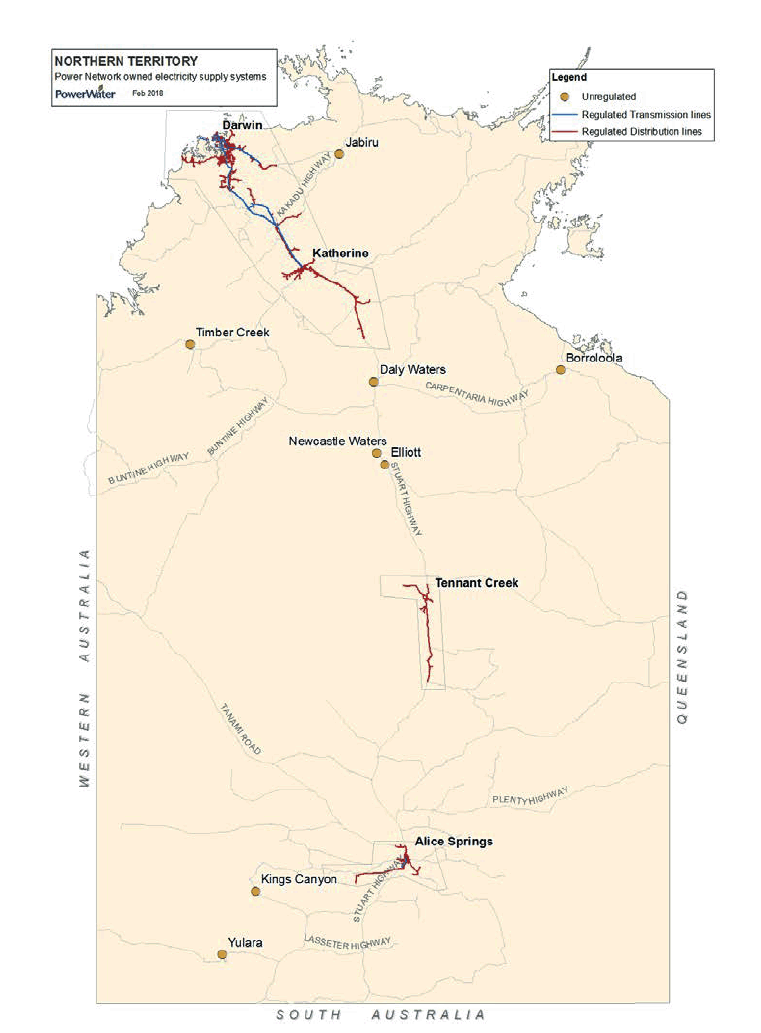 NT Electricity Grid Map (Click to enlarge) Darwin is 1,300 km or 800 miles in a straight line from Alice Springs. The Renewable Crash Test Dummy Country is aiming to be using 82% renewable electricity by 2030, but instead of making sure this works on a small scale at any one of our remote microgrid locations, where electricity is expensive to start with, we thought we’d do the experiment on the whole nation instead.
So it is “sobering” to see how this fails at Alice Springs. If there was a place on Earth that is well suited to wind and solar power, it surely is Alice Springs which is 1,200 kilometers from the Northern Territory’s main electricity grid. Surrounded by a million square kilometers of largely uninhabited arid land, if we can’t plaster enough solar panels and windmills here to support a town of 25,000 people with no heavy industry to speak of, where can we?
Yet the bare truth is that solar energy provides just 13% of Alice Springs annual electricity, and fossil fuel based generation, they admit quietly near the bottom of an FAQ page, is, shhh, 87%. Only one in four houses has solar power, yet the grid is already overloaded when it peaks, and unstable when a cloud comes over and the whole towns solar power goes down. (As it did in 2019 leaving many homes blacked out, as the engineers predicted would happen).
So the “news” that the ABC reports is that someone has a plan to push Alice Springs from 13% to 50% renewable energy by 2030. Despite this daunting task, ponder that the ABC is excited today that one small, extremely sunny isolated location might, in our wildest dreams, manage to achieve a bit more than half the target we set for the whole nation by 2030, but only if we spend $150 million (and over 20 years?).
This is called “Leading the Country” — where they fail to meet the targets before everyone else does…
When Victoria Ellis says “energy” below she means electricity.*
By Victoria Ellis, ABC “News”
According to the Alice Springs Future Grid website, about a quarter of Alice Springs homes have solar panels, and over a year about 13 per cent of the town’s energy comes from solar, but if more solar energy is added without further planning, the small electricity grid could become unstable.
The Alice Springs Future Grid website says if solar panels across the town are generating a lot of power in the middle of the day and a cloud bank suddenly shadows them, their electricity production may drop more quickly than an alternative power source can be drawn upon, leading to a blackout.
Alice Springs Future Grid director Lyndon Freason said in today’s system, there is sometimes lots of solar being produced that is not used by the grid.
“It’s becoming increasingly difficult to efficiently absorb more renewables in the middle of the day when the sun is shining, without actually causing instability in the existing generation,” he said.
So the only problem with solar power is that there is either too much electricity or not enough, or it disappears when the clouds come over, needs constant back up, and it can’t stabilize the frequency, right? And then there is the duck curve. Look at the ramping rate required from 4 to 6pm:
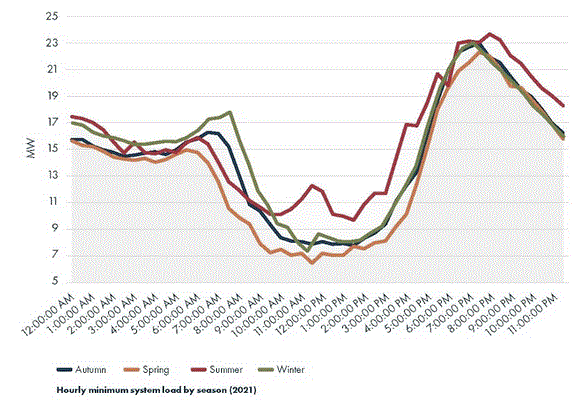
The belly of the duck is the fall in the need for electricity at noon as solar peaks. The belly can’t be allowed to sink too far, because the gas/diesel power plant needs to keep running to keep the frequency stable.
The “Roadmap” such as it is, is four scenarios with a bit more-or-less of this and that:
Click to enlarge (From the PDF)
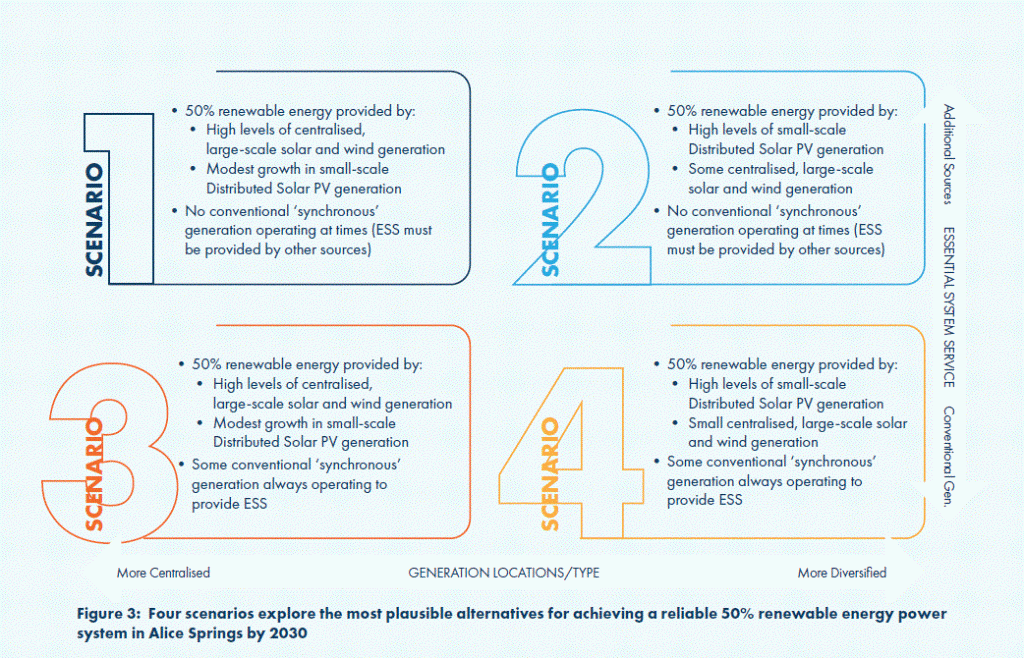 Roadmap Grid plan Alice Springs The costs, the costs:
I don’t know if anyone has mentioned that 2030 is not 20 years away:
Mr Cocking [CEO of Desert Knowledge Australia] estimated implementing one of the scenarios would cost about $150 million over 20 years.
“Ideally it would come from government, but most likely as well some private investment,” he said.
More detailed estimates (page 63) suggest the costs could be as high as $216 million, but there will theoretically be about $50 million in fuel savings.
It still works out as $6,000 per man, woman and child — which no one has to spend at all — because they just built the current diesel-gas power plant there in 2011 and upgraded it in 2018 at a cost of $75 million. Should we ask the people of Alice Springs if they’d rather have the money? For a family of four that’s $24,000. Might be nice?
But as a microcosm of a national transition the Alice Springs mini grid speaks volumes about how absurd the whole crusade is.
Currently when the wind and sun are asleep the town gets electricity from the Owen Springs Power Station which is a gas/diesel plant that can provide 80 megawatts whenever they need it. There is also an old power station built in 1973 that is still operational and a 5MW Battery Energy Storage System (BESS). Proportional to the size of the Alice Springs grid, it is (or was) effectively the “biggest battery” in Australia when it was installed in 2018. It is used mainly for stability and emergency power when the clouds roll over so the gas plant can ramp up. If it were to be used mostly for storage, the $8 million battery would only last about 20 minutes, or maybe 40, tops. This doesn’t scale well to a nation of 27 million people.
For the record, a mini-Snowy 2.0 scheme is not possible in Alice Springs. There are some worthy hilly areas for sure, but annual total rainfall is barely 280mm or 11 inches, and quite random.
Don’t wash those solar panels?
Curiously, the tap water in Alice Springs is worse for the solar panels than the dust is:
Detailed studies have been conducted on this subject, concluding that dust does not have a significant impact on PV systems. This is perhaps surprising, but washing the panels with tap water in places where there is a high concentration of calcium (such as Alice Springs) can actually have a more negative effect than dust. The arrays at the DKA Solar Centre are washed once a year by a specialised company who use a reverse osmosis filtration system to treat their water before using it to wash the solar modules. ( from the FAQ.)
Those key statistics from the FAQ of the “Alice Springs Future Grid” (which is the current grid)
In the 2021‑22 reporting period, total conventional generation capacity was 122.6 MW and operational maximum demand was 48.6 MW, not including requirements for system redundancy. It is noteworthy, however, that while the Ron Goodin power station is aged, it remains available for system redundancy. No definitive retirement date has been announced.
Over recent years, more than 25% of the approximately 9,000 households in Alice Springs have installed DPV on their property rooftops.
The maximum output capacity of all residential DPV systems in Alice Springs is estimated to be 23 MW, and historical generation data suggests in the order of a 9% contribution to overall consumption. Fossil fuel-based generation produced 87% of annual volume and centralised Renewable Generation produced 4%.
See the FAQ for more.
*Obviously solar power is not providing 13% of the towns energy – which also includes petrol, oil and gas.
10 out of 10 based on 102 ratings
9.7 out of 10 based on 12 ratings

By Jo Nova
Chronicling the collapse of the Big-Government-made EV bubble
In today’s EV obituary column, Elon Musk has dropped a bombshell. Two months after Telsa chargers became the industry standard (which promised to save the other car makers) his profits fell, and he’s fired the entire EV charging team overnight. Hertz, meanwhile, has realized that dumping 20,000 electric cars in January was not enough, and it has to offload another 10,000 electric cars, which now amounts to half its EV fleet. And then comes the news that there might be a secondhand “timebomb” coming at the eight year mark when most EV battery warranties run out and cars will become “impossible to sell”.
As if that’s not enough, this week the fire and rescue experts in NSW are warning in the politest possible way, that they might have to do a “tactical disengagement” of a car accident victim, which means leaving them to die in an EV fire if the battery looks likely to explode. They say that first responders need more training, as if this can be solved with a certificate, but the dark truth is that they’re talking about training the firemen and the truck drivers to recognize when they have to abandon the rescue.
Jennifer Dudley-Nicholson, The Driven
The NSW government’s Electric and Hybrid Vehicle Batteries Inquiry heard testimony from fire and rescue services, paramedics, the Motor Traders’ Association, and TAFE on Tuesday in its second public hearing.
In the most serious incidents, firefighters said crews could be forced to abandon rescues or crudely rescue passengers from vehicles, and were being left “flying blind” at battery fires.
VRA Rescue NSW Commissioner Brenton Charlton told the inquiry worse outcomes were also possible, including battery explosions in which a rescue operation would put emergency workers at risk.
“We need to prepare ourselves and our volunteers… for the point in time we have to do a tactical disengagement, meaning if someone’s trapped and it does high order (explode) you might not be able to do anything,” he said.
“That will be a tragic, horrible thing to take part in.”
Just like that, Elon Musk fired the whole Tesla EV charging team, throwing the industry into chaos because Tesla network is the best by far and the bedrock of the so called “transition”. Tesla had agreed to open its charging network to other EV makers only recently, and Joe Biden was delighted. Tesla is getting subsidies to expand it’s North American Charging Standard (NACS) system. But this move has shaken the whole industry.
By David Ferris, E&E News
In a single stroke, CEO Elon Musk called his company’s vaunted charging reliability into question when he laid off most or all of Tesla’s Supercharger team, the people who made Tesla the envy of the EV industry. The network they built is bigger, faster, smarter and more reliable than any other company’s — and has become the linchpin of the auto industry’s plan to persuade millions of Americans to buy EVs and turn the tide on climate change.
“It feels like the rug just got pulled out from under a lot of the industry alignment that has been built in the last 12 months,” said Matt Teske, an industry veteran and CEO of Chargeway, an EV-charging software platform. “And leaves us on shaky ground.”
In 2022, as traditional automakers finally started delivering a substantial number of EVs to the roadways, they ran into a problem. Their drivers couldn’t use Tesla’s chargers, because they were meant only for Teslas. And the public networks had an array of reliability problems.
Ford was the first automaker to hit on the solution. Last spring, it struck a deal with Tesla to use its 12,000 U.S. charging stations and committed to building Tesla’s charging technology called the North American Charging Standard, or NACS, into its future vehicles.
Other automakers followed suit in short order. By February, Tesla’s NACS had become the industry standard, with virtually every automaker planning to redesign their charging systems to meet Tesla’s specifications.
UPDATE: Elon explains it’s just a change of pace:
Tesla still plans to grow the Supercharger network, just at a slower pace for new locations and more focus on 100% uptime and expansion of existing locations
And the crowd is baffled. People are mostly aghast…
The Hertz debacle truly might become an obituary
 Originally Hertz was going to buy 100,000 wonder-cars which would be cheap to fix and popular with punters. But the future fleet only reached 60,000 cars and is now reversing back to 30,000 cars which tourists apparently don’t want to rent much, and which cost twice as much to repair. Originally Hertz was going to buy 100,000 wonder-cars which would be cheap to fix and popular with punters. But the future fleet only reached 60,000 cars and is now reversing back to 30,000 cars which tourists apparently don’t want to rent much, and which cost twice as much to repair.
Not surprisingly, it’s a financial ruin. Hertz shares have lost three quarters of their value since 2022.
The company was an $11 billion dollar company in 2021 when it announced the mass EV purchases — it is now a $1.4 billion dollar company.
RENTAL car giant Hertz, has announced that it is selling off 10,000 more EVs than it planned in January when it set out to stem the tide of massive depreciation that hit its fleet of 60,000 EVs.
Rental car companies need to be able to sell off their ex-rentals for a reasonable sum, but just as Hertz realized it couldn’t afford to repair these cars, it also realized it couldn’t sell them either:
…the program came under stress when Tesla began discounting its cars last year.
This set off a tsunami of depreciation for existing Tesla owners; including Hertz, which had the biggest exposure of anyone. In turn, other EV makers followed suit with discounts and retained values for all EVs became a race to the bottom.
And as word spreads, possibly no one else will be able to sell them either. What is an 8 year old EV with no battery warranty worth? It’s pot luck whether it will keep going or suddenly need a £15,000 repair…
The used electric car timebomb – EVs could become impossible to sell on because battery guarantees won’t last – find out if you are affected
By TOBY WALNE, This is Money
Money Mail can today reveal a timebomb looming in the second-hand market for electric vehicles (EVs).
Our investigation found that many EVs could become almost impossible to resell because of their limited battery life.
Experts said that the average EV battery guarantee lasts just eight years. After this time, the battery may lose power more quickly and so reduce mileage between charges.
In some cases, the cost of a replacement battery is as much as £40,000. For certain EVs, the cost of replacing the battery could be ten times the value of the vehicle itself on the second-hand market.
Yet geniuses in government still want to push us all into EV’s.
With uncanny timing the Australian Albanese government is about to launch emissions standards we don’t need to force people to buy a product they don’t want, in the hope, so they say, of stopping some storms.
The insanity would be hard to fathom if EV’s weren’t also the ideal tool for spying, data collection, law enforcement, and political control. Benefits that can launch a thousand political careers…
Thanks to Paul Homewood of Notalotofpeopleknowthat
10 out of 10 based on 103 ratings
10 out of 10 based on 8 ratings
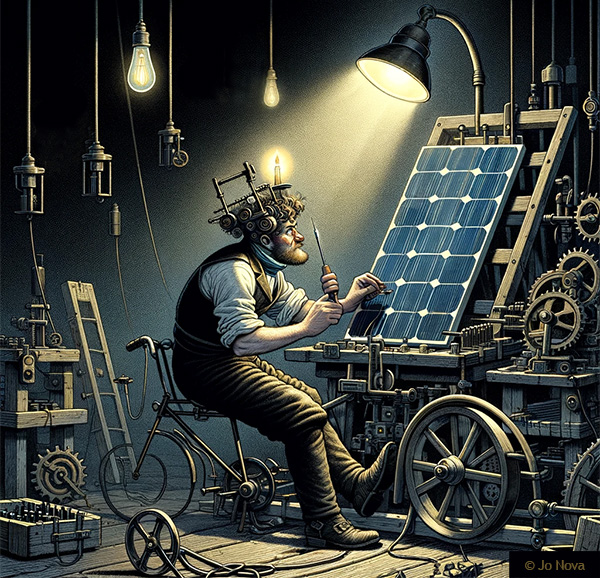 … By Jo Nova
About 90% of solar panels installed in Germany come from China, and earlier this year one of the last solar panel manufacturers closed in Germany. Last week, what was left of the industry begged for mercy (and subsidies) which they didn’t get. Now another German solar panel manufacturer has closed down.
For some cruel reason German factories which are close to their customers, can’t compete with distant foreign factories which have access to slave labor, fossil fueled shipping and cheap coal fired electricity?
The bigger question, seemingly, is how did the country that invented the printing press, diesel engines, and the theory-of-relativity get fooled by such a stupid ploy? Someone told them they could save the world with unreliable energy, so they converted their generators to unreliable ones, only to discover that they can’t afford to use unreliable generators to make the unreliable generators they need to keep saving the world?
The only government stupider than Germany is the one that has already seen how badly this worked out and announces they’re going to do the same thing. Australia is not only ten years too late, but China has flooded the market to the point where people are using solar panels as garden fences, and we have our own glut of solar power at midday.
The last hope of the German solar industry was a government mandated “bonus” for people who bought German solar panels.
April 23rd:
Benjamin Wehrmann CleanEnergyWire
Carsten Körnig, head of solar power lobby group BSW, …added that the solar industry was disappointed by the decision to leave out a “resilience bonus” for installations made in Europe. Given the stiff competition between producers in the U.S. and Asia for securing a share of the market in solar panel production, Körnig said including the bonus in the package would allow Germany to achieve greater supply security for the important future technology, adding that it is “perhaps the last chance for a renaissance of Germany’s solar industry”.
April 30:
Carolina Kyllmann CleanEnergyWire
Solar panel manufacturer Solarwatt is set to halt production of solar photovoltaic (PV) modules in its factory in Dresden, business daily Handelsblatt reported. “Under the current circumstances, running a production facility here in Germany is extremely difficult economically, and we cannot justify this,” Solarwatt head Detlef Neuhaus told the newspaper. The plant with an annual production capacity of 300 megawatts (MW) will close “for the time being” at the end of August, with 190 jobs directly affected by the shutdown.
China generates 60% of its electricity with coal, while Germany uses 32% coal, and 30% solar-and-wind power. What should Germany do, bring back coal, or get some slaves?
Solar panels are now in the “top five” worst slave industries in the world, yet still barely any of the morality-police care. They’re apparently too busy atoning for slavery they didn’t cause that doesn’t exist anymore to worry about slaves that are alive today.
9.9 out of 10 based on 126 ratings
10 out of 10 based on 10 ratings

Image by Manuel Angel Egea
By Jo Nova
Only 18 months ago the Australian government gave $14 million dollars to Andrew “Twiggy” Forrest to figure out if his team could build a 500MW electrolyser to make hydrogen gas on an island near Brisbane. It was going to be a glorious Australian green-techno future, the largest hydrogen plant in the world, but it’s missed three deadlines in the last three months to greenlight the project. Instead the Australian company is going overseas.
As Nick Cater points out this part of the made-in-Australia renewable superpower is going to be made-in-Arizona because they still have cheap electricity — a miraculous 7.5c a kilowatt hour!
Nick Cater, The Australian
Bowen described the project’s success as “critical” to Australia’s ambition to be a green energy superpower.
It turns out abundant sun was not such a competitive advantage in the manufacture of green hydrogen. Low taxes, fiscally responsible government and cheap and reliable carbon-free energy are far more appealing drawcards for investors.
The future is already being built in Buckeye, Arizona, where Fortescue is investing $US500m ($765m) in a green hydrogen plant it says will be up and running by 2026.
In 2023, manufacturing in Arizona grew faster than in any other state. It includes energy and water-intensive industries such as silicon chip manufacturing, with Arizona coming from nowhere to fourth place among US states.
..It isn’t hard to work out why. Arizona’s top state income tax rate is 2.98 per cent. … For energy-hungry industries such as hydrogen and the IT sector, however, the biggest attraction is the industrial electricity price: 7.47 cents a kWh in Arizona compared to 18 cents in California.
Our electricity prices are twice as high as any hydrogen industry could bear
We are so far out of the running. Last month the boss of Fortescue Energy said he was hoping our prices would fall (by half!), and cites Norway as an example of “cheap renewable energy” as if we could emulate that. It’s a bit rich given that the only renewable energy Norway uses is hydropower (96%). Norway has 31GW of hydropower while we have 4GW and can’t even tack on a 2GW pumped hydro dessert. To put it bluntly, Norway has a thousand fjords and a half million lakes and Australia has no fjords and about fifty salt lakes.
By Peter Kerr, Australian Financial Review, March 11 2024
Mr Hutchinson [Fortescue Energy boss] told The Australian Financial Review Business Summit that high power prices were the main impediment at Gibson Island. “We’ve been working very, very hard on it,” he said. “But it’s tough based on the current power prices when we’re looking at competing globally. It’s a tough decision.
The company expects to approve a green hydrogen project in Norway this year which would be powered by carbon-free hydroelectricity. “If you look around the world where you can get cheap renewable power, competitive renewable power is below $US30 a megawatt hour,” he said.
 The irony is that to make hydrogen he needs the cheap power we used to have on the Australian national grid before we started adding renewables (after 2008 when Kevin Rudd was elected). For twenty years the whole Australian grid price was about $30 a megawatt hour. At a point after 2012, when the carbon tax was added, electricity prices rose up beyond the $50 per megawatt hour price limit that makes hydrogen industry unrealistic, and never came back down. The irony is that to make hydrogen he needs the cheap power we used to have on the Australian national grid before we started adding renewables (after 2008 when Kevin Rudd was elected). For twenty years the whole Australian grid price was about $30 a megawatt hour. At a point after 2012, when the carbon tax was added, electricity prices rose up beyond the $50 per megawatt hour price limit that makes hydrogen industry unrealistic, and never came back down.
Once upon a time, Australia had electricity so cheap no one would have bought hydrogen. Now electricity is so expensive, hydrogen might be competitive, except no one can afford to make it.
Like the Penrose impossible triangle, just keep going left and it never makes sense.
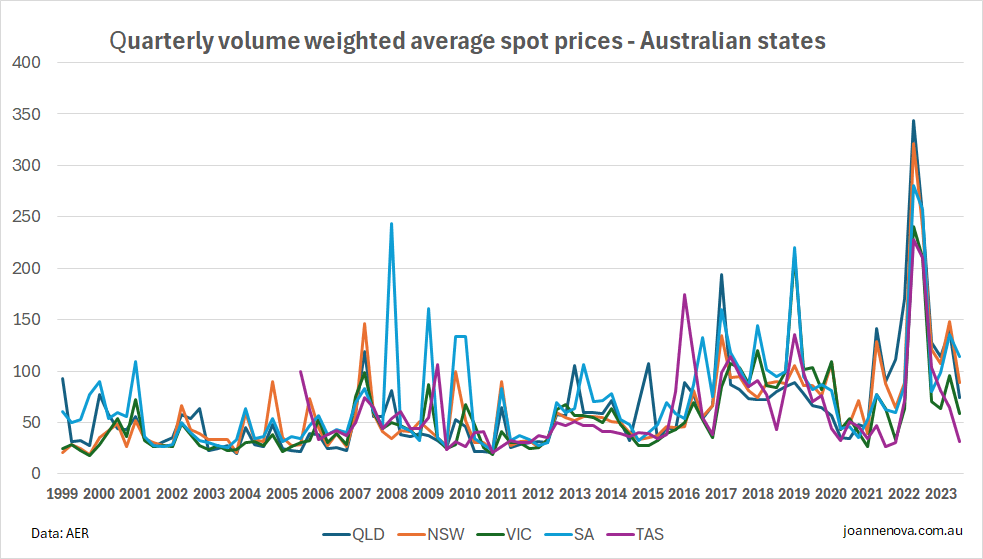
REFERENCE
AER quarterly wholesale electricity prices 1999- 2023
9.9 out of 10 based on 92 ratings
9.5 out of 10 based on 10 ratings
8.1 out of 10 based on 25 ratings
8.8 out of 10 based on 28 ratings
By Jo Nova
Remember when Ford was just losing $38,000 on every EV? Those were the good days
The biggest star in the automotive world at the moment is a black hole, and it’s swallowing whole industrial giants. It’s hard to imagine a faster way to sabotage whole nations than to disguise your spies as academics and environmentalists. Then get them to convince the government to command a whole new market into existence in a highly technological field with the wave of a legislated wand.
These numbers are astronomical:
By Chris Isodore, CNN: Ford’s electric vehicle unit reported that losses soared in the first quarter to $1.3 billion, or $132,000 for each of the 10,000 vehicles it sold in the first three months of the year, helping to drag down earnings for the company overall.
Ford, like most automakers, has announced plans to shift from traditional gas-powered vehicles to EVs in coming years. But it is the only traditional automaker to break out results of its retail EV sales.
 We can only wonder what’s happening at other companies. We can only wonder what’s happening at other companies.
The EV unit at Ford sold 10,000 cars in the first quarter this year, which is 20% fewer cars than they did a year ago. It’s that bad. In fact it’s worse. Those cars were also discounted. So the revenue mostly went beyond the event horizon — and fell an astonishing 84%.
Ford is expecting losses in the order of $5 billion for the full year. Their aims now are so low, they just hope one day to sell the cars for enough to cover the cost of making them, perhaps. They can’t hope to cover the millions spent on R&D in the foreseeable future. Indeed, even covering the costs in a market with a price war is said to be “very difficult”.
Meanwhile, two days earlier the IEA chief said the EV revolution was rolling on just fine:
CNN readers must be confused.
[CNN] Global electric vehicle sales are set to rise by more than a fifth to reach 17 million this year, powered by drivers in China, according to the International Energy Agency.
In a report Tuesday, the IEA projected that “surging demand” for EVs over the next decade was set “to remake the global auto industry and significantly reduce oil consumption for road transport.”
So the global EV market is being powered by “drivers in China”, like these drivers perhaps who left their brand new EV’s rotting in fields in China. That would be imaginary drivers?
 Chinese EV’s rotting in a field The propaganda never ends.
As Stephen Wilmot said in The Wall Street Journal last year, if Ford just canned the EV unit, its adjusted operating profit would be 50% higher. Surely that beckons…
Hat tip to Marc Morano @ClimateDepot
9.9 out of 10 based on 108 ratings
9.1 out of 10 based on 14 ratings
|
JoNova A science presenter, writer, speaker & former TV host; author of The Skeptic's Handbook (over 200,000 copies distributed & available in 15 languages).

Jo appreciates your support to help her keep doing what she does. This blog is funded by donations. Thanks!


 Follow Jo's Tweets
Follow Jo's Tweets To report "lost" comments or defamatory and offensive remarks, email the moderators at: support AT joannenova.com.au
Statistics
The nerds have the numbers on precious metals investments on the ASX
|












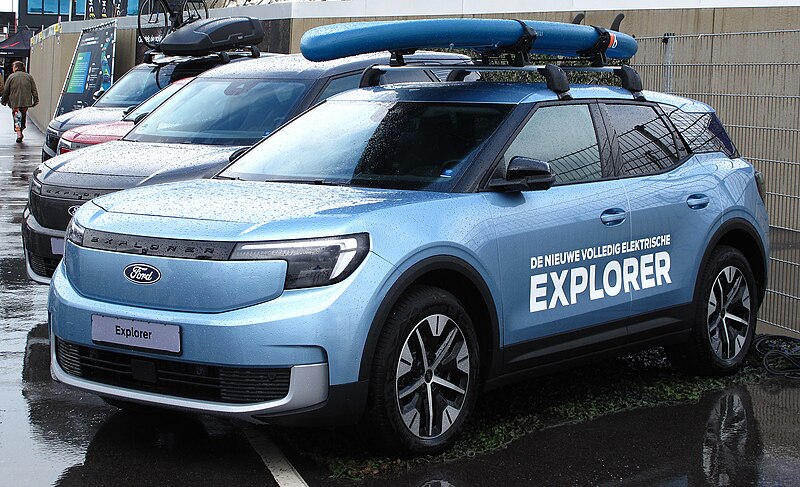













Recent Comments